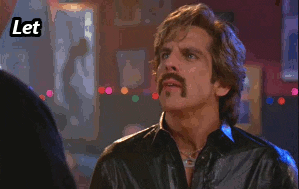Everything You Need To Know About Rounding Your Back In The Deadlift
“Strong people are harder to kill than weak people and more useful in general.”
Do you know the first thing they teach you in personal trainer school?
It’s not how to wear our t-shirts two sizes too small, count to ten while keeping conversation, or how to scream in the face of our wavering clients in just the right way so they eek out that final, grueling rep.
The first and most important thing they teach us is -
Don’t let your back round when performing the deadlift.
It’s dangerous, wrong, and flat out ugly, they say. Your back must stay straight as an arrow or else…
Or else, what?
That’s the question of the day. The answer, and I’m being DEAD-serious, may surprise you.
What if I told you that lifting with a rounded back doesn’t increase injury risk? Or that it might even help you lift heavier weight and gain more strength?
In the article, you’ll learn:
If deadlifting with a rounded back increases your injury risk
How rounding your back, in the right way, will make you stronger
Why you shouldn’t be worried if your form isn’t 100% perfect all of the time
Spoiler alert - Lifting with a rounded back isn’t the spine-chilling, spine-snapping boogeyman that it’s made out to be.
Does rounding your back during the deadlift increase injury risk?
The number one knock against lifting with a rounded back is that it increases shear force on your lumbar spine. Excessive lumbar rounding, also called spinal flexion, may increase risk of disc herniation and other injury.
Although this makes sense from a biomechanical standpoint, the supporting evidence for a rounded back increasing injury risk in humans is limited (1).
Along the same lines, research suggests that workers in physical professions (baggage handlers, mail workers, etc.) that are trained to lift with a flat back do not have fewer low back injuries as a result (2).
That said, it’s best to limit rounding in your lumbar spine (low back). On the other hand, rounding your thoracic spine (mid-upper back) is not nearly as risky.
Here’s why:
Your upper back is naturally rounded while your low back is slightly curved.
The natural curves in your spine (3)
So, allowing your upper back to round more from its already slightly rounded position places less shear force on your spine than letting your low back round excessively from its naturally arched position.
KEY TAKEAWAY - Rounding your upper or mid back during deadlifts is probably fine. Excessively rounding your low back, like in this atrocity here, may not directly cause injury but does place undue stress on your lumbar spine - which may lead to pain or injury over time (4).
Other trainers and physical therapists, what do you think? I’d love to hear your thoughts.
Does rounding your back increase strength?
The reason your back tends to round a bit when you deadlift very heavy weights is because it actually makes you stronger! Allowing your upper back to round when picking a heavy weight off the ground places allows your back muscles to exert more force.
Let me tell you a bit about something called the length tension relationship. It basically means that your muscles are strongest at a certain length.
Take a bicep curl, for instance. At the bottom of the rep, when your arms are straight, and at the top of the rep, when your elbows are flexed, you’re not nearly as strong as the position in the middle of the rep.
Halfway through a curl, your biceps are at an optimal length to produce force. Now, apply that to the deadlift.
(For a big time nerd deep dive on the length tension relationship, you can learn more here (5).
During a bicep curl, you’re strongest at the mid point because your muscles are in an optimal position to produce force (6).
You don’t want your back muscles fully lengthened or fully shortened if max strength is your goal. Just like the good stuff in an Oreo, you want to be right in the middle.
So, that means a bit of rounding is good for strength.
If you apply the length tension relationship to a deadlift, you’ll see that keeping your back muscles perfectly straight (shortened) is not best for max strength (6).
Additionally, a rounded back allows the hips to get closer to the bar, reducing the torque requirement that the hips and glutes need to overcome. Less torque requirement means you’re able to lift heavier weight.
The evidence backs it up, too. Researchers have found that lifting with a rounded back puts your muscles in a better position to lift more weight (7).
This is why the heaviest deadlifts performed by the strongest super humans in history are never performed with textbook form.
Take this 1,100 lb deadlift by Hafthor Bjornsson, for instance (8):
Sure, his back rounds a bit. But there are two things that I know for certain:
Nobody in his/her right mind would ever tell that beast of a man that his form is wrong
The lift was safe, effective, and did not cause a back injury
Again, I’m not telling you to throw your form out the window. And I’m definitely not telling you to try to deadlift with a rounded back.
At a certain point when the weight gets heavy enough, like our 1,000+ lb deadlifting friend Mr. Bjornsson, you will not be able to maintain perfect form. And - I can’t stress this enough - that is nothing to be afraid of. That brings me to my next point.
KEY TAKEAWAY - Allowing your mid or upper back to round when performing a heavy deadlift is safe and effective. A slightly rounded position is more advantageous from a biomechanical perspective and will allow you to lift heavier weight.
Should you fear back rounding in the deadlift?
The deadlift is scary. Especially if you've never performed it before, it can be intimidating and confusing. To you, it might even look like a surefire way to both injure and embarrass yourself, at the same time.
I can assure you, the deadlift is not as scary as it appears.
If you perform it correctly and consistently over time, there’s a strong chance it will become your favorite exercise.
Despite all of the fear surrounding the deadlift, I want you to embrace this exercise. The deadlift is:
Safe
Time tested, performed by people around the world since at least the 1800’s (9).
One of the best exercises for increasing muscle size and definition - in almost every muscle in your body (10).
A surefire way to build functional strength that will carry over into every action you perform in life
Effective for preventing low back pain.
A tremendous way to improve self confidence
With all these benefits, you’d be crazy to avoid deadlifting just because you’re afraid of your back rounding a bit.
KEY TAKEAWAY - You, and your low back, are strong and adaptable. If your form is solid and you encounter some mid back rounding with heavier weights, it is nothing to worry about.
How to perform the perfect deadlift.
The deadlift is so appropriately named for a reason - if you don’t perform it correctly, you may end up dead.
Okay, that’s not exactly true.
But before you sprint to the gym, throw six plates on the bar, and go to town with reckless, rounded back abandon, you need to read this.
Please. Whatever you do, don’t take my advice as a green light to throw both caution to the wind and your form out the window.
The deadlift is safe and some back rounding is perfectly fine. However, it is critically important that you learn and practice proper form.
Good form is important for every exercise but especially with the deadlift because it involves two key things:
Heavy weights
Your spine
With these two factors in play, you want to get your form squared away.
Here is a quick step by step guide on how to deadlift with proper form:
Approach the bar - Step up to the bar so that it hovers over the middle of your foot (the midpoint between your toes and heels)
Set your stance - Place your feet slightly closer than shoulder width apart (for the conventional deadlift) or between 3-4 feet apart (for the sumo deadlift).
Point your toes - For the conventional deadlift, point your toes straight ahead or angle them out slightly. For the sumo deadlift, angle your toes out wider so that they’re pointing in the direction of the plates on the bar
Create tension - Without moving your feet, drive your feet out to the side like you’re trying to bust through the sides of your shoes. Another analogy - imagine there’s a million dollars underneath the floor, and the only way to access it is by pulling apart the floor with your feet and creating a hole. This tension will help “turn on” your outside hip muscles and improve your stability.
Grip the bar - Grip the bar about shoulder width apart with palms facing forward. If you’re more advanced, you might consider using an alternate grip (one hand overhand and one hand underhand) or a hook grip. More on those advanced grips here (11).
Brace your core - Taking a deep breath into your stomach and squeeze your core (basically how you would react if you’re about to get punched in the stomach). Bracing helps to increase intra-abdominal pressure and reduce risk of injury.
Lock in your lats - Next, turn your elbows in toward your sides. A cue to help remember this - think about squeezing an orange in your armpits and keep that tension throughout the rep. Turn the orange into O.J. my strong friend!
Show off your chest - Drop your hips slightly (but not so far that it looks like a squat) and squeeze your shoulder blade so that you’re showing off your chest. If you have a logo (something like, I don’t know, an avocado with biceps) on the front of your shirt, you should be able to see it in the mirror throughout the lift.
Pull the slack out of the bar - Before you lift the bar off the ground, think about pulling hard so that your arms are completely straight and the plates give a little “clink”. This is yet another step to create more tension and ensure you exert as much force as possible.
Lift the bar - Drive your legs into the ground like you're leg pressing the floor. As the bar leaves the floor, drive your hips through the bar while continuing to press with your legs.
Lower the bar - Drop the bar quickly but in a controlled way. No need to lower the bar slowly here.
Reset your form and repeat - Repeat steps 1-10 and get to work!
If you have any questions on the deadlift or want detailed feedback on your form, shoot me a message or send me a video. I’d be thrilled to help.
Why your back may be rounding too much.
When performed correctly, deadlifts will improve your strength, prevent low back pain, and build muscle. Key word - correctly.
If your low back looks like a camel’s hump when you deadlift, you might be at increased risk of injury. It’s time to fix it.
Here are 3 reasons your low back may be rounding too much during the deadlift:
1️⃣ Tight hamstrings - if you lack hamstring flexibility, you’ll have a difficult time maintaining a neutral spine with proper hip height in the starting position.
2️⃣ Weak glutes (concentrically) - if your glutes aren’t strong (concentrically), your low back may round in order to compensate.
3️⃣ Weak lumbar erectors- if your low back muscles aren’t strong (isometrically), you won’t be able to maintain extension throughout the lift.
Here’s how to fix it:
1️⃣Dynamic hamstring stretching - Walking hamstring sweeps are my favorite. Try 2 sets of 10 each leg before deadlifting.
2️⃣Hip extension strengthening - hip thrusts, back extensions, and RDL/Single leg RDL are all awesome options. Perform 2-5 sets of 6-12 reps after deadlifts or on another lower body day.
3️⃣Paused deadlifts to strengthen isometric spinal extension - deadlift as you normally would, but pause for 3 seconds at mid-point. Focus on staying as TIGHT as possible.
The deadlift is one of the most valuable exercises you can perform. Don’t miss out.
The first thing you learn in personal trainer school is to keep a straight back during the deadlifts. The second, less controversial thing you’re taught is the immeasurable value that a compound exercise like the deadlift can provide.
There’s no doubt. The deadlift is one of the most effective exercises for improving functional strength, building muscle, and reducing pain.
The last thing I want is for lack of knowledge or confidence to get in the way of you reaping the benefits of this amazing benefits.
Eliminating confusion and boosting your confidence in performing complex, muscle-building movements are the reasons that my monthly coaching includes detailed feedback on all of your key lifts.
If you want to get stronger than you ever have before in a safe and efficient way, my 1 on 1 coaching is a fantastic option.
If you’d like to learn more about working with your’s truly to accomplish your goals, sign up for your free assessment below.
Just a casual conversation where we can troubleshoot the tiny things you’re missing that are getting in the way of you feeling and performing like you need.
You can fill out your application HERE.
In the meantime, if you have any questions about YOUR deadlift form, feel free to fire away or send me a video. I’d be happy to help - that’s what I’m here for 😃
3 Steps You Can Take
Apply for coaching - If you’re ready to start, you can sign up for a free chat with me here. Best case, you change your life. Worst case, we draw up a road map to get you to your goals.
Sign up for my newsletter - If you’d like to hear more, sign up for my mailing list here.
Keep learning - You can check out my other articles here. Nobody asked me to, but I’ve spent a ton of time researching everything from artificial sweeteners to saturated fat to testosterone and more, so you don’t have to.
Have a wonderful week!
John
Sources:
https://www.youtube.com/watch?v=h44SIMOMdEI&ab_channel=crazygoat85
https://getbacktosport.com/latest-news/length-tension-relationship/
GIF Sources: Goodman Deadlift Elmo Corey Phoebe
(giphy.com)










